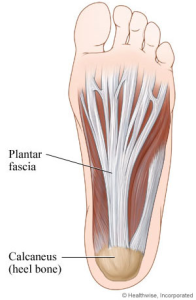
Plantar Fasciitis (pdf) is commonly thought of as inflammation of the plantar fascia. This is a thick fibrous structure that helps create and support the arch of your foot. It works both statically when you’re standing and dynamically when you’re running.
Recognizing the initial signs of plantar fasciitis checklist:
- Pain at the heel of your foot
- The pain is worse in the mornings
- Better as you move around
- Returns after a periods of sitting or standing
Are you at risk? Know Your Risk Factors:
- Overly rigid or overly flat feet
- Previous episodes
- Long distance running
- Barefoot walking/running on hard surfaces
- Improper shoes or orthotic supports
- Muscular imbalances
- Poor foot/ankle range of motion
Maintenance and prevention:
- Make sure you do a proper warm up and a proper cool down after your runs
- Vary your activity throughout the week instead of adding counterproductive “junk-miles”.
- Assess and address mobility issues especially in your foot/ankle, knees, and hips.
- Support your foot with the right shoes and if necessary orthotics
When and Why it’s important to seek care:
- If you recognize the initial sings of plantar fasciitis it is likely beyond the point of self-maintenance and prevention and will require targeted and specific care.
- Continuing to run after the initial stages without care can lead to weakening and degeneration of the plantar fascia which will likely lead to a tear of the fascia or surrounding tendons.
- There are many layers to the foot and the plantar fascia is only the most superficial and likely not the only pain generator. Thoroughness is critical and the only safe way to return to running.





